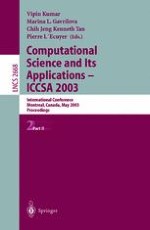2003 | Buch
Computational Science and Its Applications — ICCSA 2003
International Conference Montreal, Canada, May 18–21, 2003 Proceedings, Part II
herausgegeben von: Vipin Kumar, Marina L. Gavrilova, Chih Jeng Kenneth Tan, Pierre L’Ecuyer
Verlag: Springer Berlin Heidelberg
Buchreihe : Lecture Notes in Computer Science
Enthalten in: Professional Book Archive
